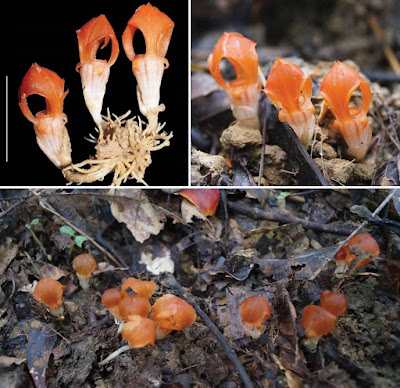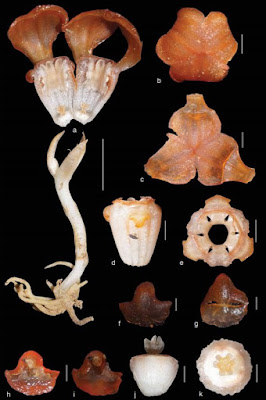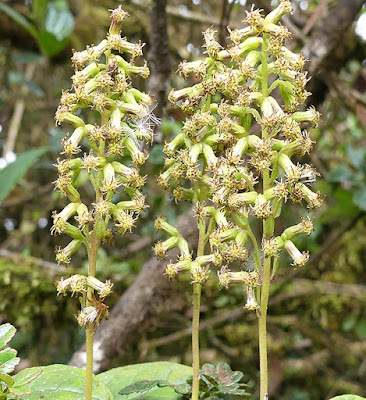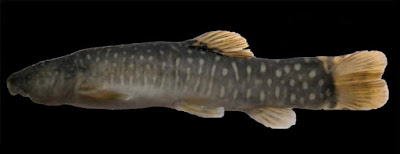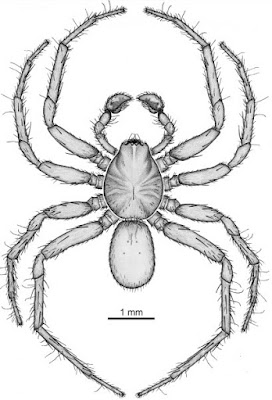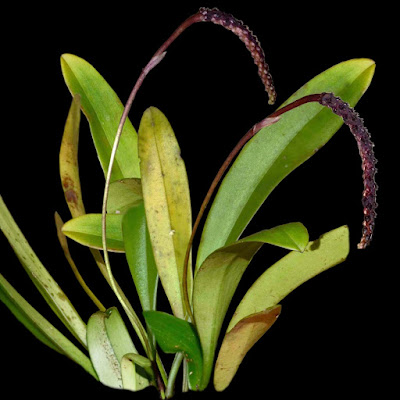[Most Recent Entries] [Calendar View]
Wednesday, September 12th, 2018
| Time | Event | ||||
| 2:05a | [Botany • 2018] Thismia aurantiaca (section Rodwaya, Thismiaceae) • First Record of the Family from Andaman and Nicobar Islands, India with A New Species
Abstract Thismia is a mycoheterotrophic genus in the family Thismiaceae. We report a new family record for Andaman and Nicobar Islands and a new species for India. A detailed description along with conservation assessment, colour photos, distribution map, and key to the species from India are provided. Keywords: Andaman Islands; Rodwaya; Thismia; Thismiaceae; new record; new species Thismia aurantiaca Hareesh & M.Sabu, sp. nov. This species is similar to T. rodwayi but differs from the latter in having outer perianth lobes 5 times larger than inner perianth lobes (vs sub-equal), broadly triangular recurved outer perianth lobes (vs spathulate, up-curved) and inner perianth lobes with minute 0.5 mm long, erect mitre (vs well developed more than 1 mm long, bent and inter locking mitre). Type: M. Sabu & V.S. Hareesh 152774 (holo CALI; iso CAL, PBL), India, Andaman Islands, South Andaman, Mount Harriet National Park, elevation ± 320 m, 7 Aug. 2017. Etymology. The name ‘aurantiaca’ denotes the orange coloured flower of the plant.
Habitat & Ecology — So far, we could observe three populations with around 18 individuals each in the evergreen forest patches of Mount Harriet National Park, South Andaman. The plants are growing in a damp habitat in the understory of evergreen forest in association with Amomum andamanicum V.P.Thomas, Dan & M.Sabu (Zingiberaceae), Dipterocarpus sp. and Hopea sp. (Dipterocarpaceae), Phrynium sp. (Marantaceae), Malaxis sp. (Orchidaceae). V.S. Hareesh, J.P. Alappatt and M. Sabu. 2018. Thismia aurantiaca sp. nov. (section Rodwaya, Thismiaceae): First Record of the Family from Andaman and Nicobar Islands, India with A New Species. Blumea - Biodiversity, Evolution and Biogeography of Plants. DOI: 10.3767/blumea.2018.63.02.08 | ||||
| 9:28a | [Botany • 2018] Two New Species of Pentacalia (Compositae, Senecioneae) from northern Andes
Abstract Recent collections carried out in southern Colombia (Putumayo) and southern Ecuador (Zamora-Chinchipe) lead us to describe two new species of Pentacalia based on morphological evidence. One of them displays lateral, axillary synflorescences and disciform capitula, whereas the other keys out in the group of terminal synflorescences and disciform capitula. Taxonomically useful characters are provided to easily distinguish each species from its closest relatives, as well as detailed pictures of living plants and distribution maps. Adjusted keys for the Colombian and Ecuadorian species are also presented. Keywords: Eudicots, Asteraceae, Colombia, dichotomous key, Ecuador, montane forest, paramo, taxonomy Joel Calvo and Antoni Buira. 2018. Two New Species of Pentacalia (Compositae, Senecioneae) from northern Andes. Phytotaxa. 364(2); 193-201. DOI: 10.11646/phytotaxa.364.2.6 | ||||
| 9:37a | [Botany • 2018] Disporum mishmiensis (Colchicaceae) • A New Species from North East India
Abstract Disporum mishmiensis, sp. nov. is described from Arunachal Pradesh, north-eastern India. A detailed description and colour photographs of D. leucanthum are provided to aid identification. A distribution map, notes on ecology and a key to Indian species are provided. Keywords: Arunachal Pradesh; Disporum; India; Mishmi Hills Disporum mishmiensis Hareesh & M.Sabu, sp. nov. Disporum mishmiensis is similar to D. leucanthum but differs from it in having a campanulate perigone with pink tepals that are 2.7–3 cm (vs 1.2–2 cm), filaments 14–16 mm long (vs 8–15 mm), a style 16–18 mm long (vs 6–12 mm), and a non-stoloniferous/rhizomatous growth habit. — Type: M.Sabu & V.S.Hareesh 149366 (holo CALI; iso CAL, CALI), India, Arunachal Pradesh, Lohit District, near Tohangam view point, on the way to Hayuliang from Tezu, ..., 16 May 2017. Etymology. The name mishmiensis denotes the type locality, Mishmi Hills which is a part of the eastern hills of Arunachal Pradesh adjacent to Myanmar Hareesh, V.S., Floden, A. and Sabu, M. 2018. Disporum mishmiensis (Colchicaceae), A New Species from North East India. Blumea - Biodiversity, Evolution and Biogeography of Plants. DOI: 10.3767/blumea.2018.63.02.05 | ||||
| 9:43a | [Ichthyology • 2018] Schistura alboguttata • A New Loach Species (Cypriniformes: Nemacheilidae) from the Pearl River basin in Guangxi, South China Abstract Schistura alboguttata, a new species of nemacheilid loach, is herein described from the Leli-He, a tributary flowing to the You-Jiang of the Pearl River basin (Zhu-Jiang in Chinese) at Tianlin County, Guangxi, South China. This new species can be readily distinguished from all other Chinese species of Schistura by its striking body coloration consisting of irregular white spots scattered over the dorsal and lateral regions of the body, with occasional irregular bars with narrow interspaces on the predorsal region. Keywords: Pisces, nemacheilid, new species, Zhu-Jiang
Schistura alboguttata, sp. nov. Etymology. The specific epithet is derived from the Latin albus (white) and guttata (spotted), in reference to the irregular white spots scattered over the dorsal and lateral regions of the body. Liang Cao and E. Zhang. 2018. Schistura alboguttata, A New Loach Species of the Family Nemacheilidae (Pisces: Cypriniformes) from the Pearl River basin in Guangxi, South China. Zootaxa. 4471(1); 125–136. DOI: 10.11646/zootaxa.4471.1.5 | ||||
| 10:15a | [Arachnida • 2018] Chinja gen. nov. • A New Genus of Spider (Araneae, Zoropsidae) from the Eastern Arc Mountains of Tanzania; Chinja chinja & C. scharffi
Abstract The new zoropsid spider genus Chinja Polotow & Griswold is diagnosed and described and the following two new species are described: Chinja chinja sp. nov. and C. scharffi sp. nov. The species were collected in the Eastern Arc Mountains of Tanzania and appear to be endemic to this region. The genus belongs to the oval-calamistrum clade (OC Clade), which also includes Dionycha and Lycosoidea. Based on the synapomorphies and diagnostic characters of members of the OC Clade, Chinja is considered a member of Zoropsidae, although without a clear subfamily placement due to insufficient data. Males of Chinja can be distinguished from other Zoropsidae by a straight PER, by lacking a tibial crack, by having a male palpal cymbium with a retrobasal process and the male palpal tibia with an RTA and a retromedian cluster of stout setae. Females have a divided cribellum with cribellar spigots evenly arranged, and the epigynum with the median plate broad and laterally procurved into hooks, and the lateral lobes each with a wide tooth. The following set of characters can be also helpful to identify the genus: presence of a third tarsal claw, absence of claw tufts and presence of a cribellum and calamistrum. Keywords: Araneae, Africa, Eastern Arc Mountain Hotspot, Lycosoidea, OC Clade, new species TAXONOMY ZOROPSIDAE BERTKAU, 1882 Type genus: Zoropsis Simon, 1878: 327 (Type species by monotypy: Dolomedes spinimanus Dufour, 1820) Composition. The living Zoropsidae include 26 genera and 180 species (World Spider Catalog 2018). Wunderlich (2017) recognizes four genera and 16 Palaeogene, extinct species from Bitterfeld and Baltic amber. Distribution. Worldwide. Chinja Polotow & Griswold, new genus Etymology. Name is an arbitrary combination of letters and is to be considered feminine in gender. Type species. Chinja chinja sp. nov., here designated. Composition. Two species: Chinja chinja sp. nov. and C. scharffi sp. nov. Natural history. All species have been collected in the leaf litter and on the soil surface of closed-canopy, moist forest. Although the cribellum and calamistrum appear functional, we have no data on the web, if any. Distribution. Endemic to the Eastern Arc Mountains of Tanzania. Chinja chinja sp. nov Etymology. The species epithet is an arbitrary combination of letters. Natural history. This species occurs in the leaf litter and on the soil surface of closed-canopy, moist forest. Distribution. Eastern Usambara Mountains, Tanzania.
Chinja scharffi sp. nov. Etymology. The species epithet is a patronym in honor of Nikolaj Scharff, a leader in biodiversity studies and conservation in the Eastern Arc Biotic Hotpot of Tanzania and collector of this and many other endemic Eastern Arc species. Natural history. This species occurs in the leaf litter and on the soil surface of closed-canopy, moist forest, and is found at low (700 m) to high (1850 m) elevations. Distribution. Uzungwa and Uluguru Mountains, Tanzania. Daniele Polotow and Charles Griswold. 2018. Chinja, A New Genus of Spider from the Eastern Arc Mountains of Tanzania (Araneae, Zoropsidae). Zootaxa. 4472(3); 545–562. DOI: 10.11646/zootaxa.4472.3.7 | ||||
| 10:25a | [Botany • 2018] New Species of Bulbophyllum (Orchidaceae) in the Flora of Vietnam Abstract Three taxa, Bulbophyllum cariniflorum var. orlovii (sect. Pleiophyllum), B. sonii (sect. Anisopetalon) and B. ustulata (sect. Brachystachya) are described as new for science. All of these novelties are local endemics of Vietnam. Additionally, four species, B. flavescens (sect. Aphanobulbon), B. ovatum (sect. Desmosanthes), B. physocoryphum (sect. Macrocaulia) and B. wendlandianum (sect. Cirrhopetalum) are recorded for the flora of Vietnam for the first time. These species are endemic of the Indochinese Peninsula in a broad sense, except for B. flavescens having wide distribution in western Malesia. Data on ecology, phenology, distribution, brief relevant taxonomic notes, as well as colour photographs and line drawings of the type and voucher specimens are provided for all reported taxa. Lectotypification is provided for B. wendlandianum. Keywords: Orchidaceae, plant taxonomy, plant diversity, nature protection, Monocots Leonid V. Averyanov, Nong Van Duy, Nguyen Hoang Tuan, Maxim S. Nuraliev, Tatiana V. Maisak and Nguyen Cong Anh. 2018. New Species of Bulbophyllum (Orchidaceae) in the Flora of Vietnam. Phytotaxa. 369(1); 1–14. DOI: 10.11646/phytotaxa.369.1.1 |
| << Previous Day |
2018/09/12 [Calendar] |
Next Day >> |
